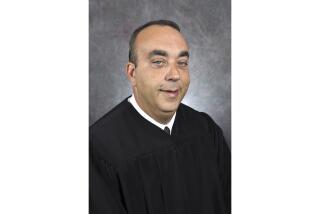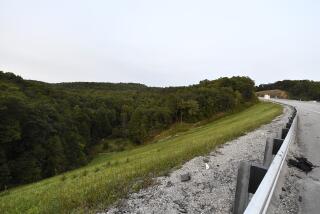Man Slain in Kansas Court Rampage : Violence: Gunman also dies when explosives attached to his torso explode. He faced sentencing on drugs and weapons charges.
- Share via
TOPEKA, Kan. — His body wrapped in explosives, a Kansas railroad accountant burst onto the fourth floor of the U.S. District Courthouse here Thursday morning, flinging pipe bombs and firing from semiautomatic pistols.
The gunman, identified as Jack McKnight, 37, who was due to be sentenced later in the day on federal firearm and drug charges, shot a security officer to death and wounded four other people. In the court clerk’s office he told one frightened woman, “You aren’t the one I’m looking for!”
At that moment, explosives attached to McKnight’s torso suddenly detonated, killing him. But for about six hours afterward, SWAT team members and FBI agents were unaware that he was dead. Believing that he was holed up somewhere in the courthouse, they kept a tense, armed vigil outside, while at least nine employees inside hid in their offices.
McKnight, an accountant for the Santa Fe Railway, was facing a mandatory minimum of 10 years in prison after pleading guilty to cultivating marijuana for sale in the back yard of his rural Meriden, Kan., home.
On his way to the federal courthouse in downtown Topeka, McKnight had left explosives that blew up his pickup truck in front of the Jefferson County, Kan., sheriff’s office. Before entering the four-story U.S. courthouse here shortly before 10 a.m. he parked next to the building, where his car burned after apparently being blown up by another bomb.
Gregory Hough, the assistant U.S. attorney who had prosecuted McKnight on the gun and drug charges, was inside his third-floor office preparing for the 1:30 p.m. sentencing hearing when his phone rang. It was the Jefferson County sheriff’s office, advising him of the truck bombing and warning him that McKnight might be headed toward Topeka.
Hough quickly called McKnight’s defense lawyer, Dick Lake, but got no answer. Then he frantically dialed the court clerk’s office on the fourth floor of the courthouse.
“A secretary answered the phone and said they were having an incident and she couldn’t talk,” Hough said. “She hung up. The phone went click.”
Next, Hough heard rapid-fire gunfire, followed by a series of explosions and screams. He herded a group of employees from his office to their law library and locked the door.
“We waited in there,” Hough said. “And all I can tell you is that if he had gotten out of the elevator on the third floor and taken the same path as he did into the clerk’s office, he would have walked right into my office.”
U.S. Marshal Kent Pekarek said that because the courthouse is used for various purposes, only the fourth and second floors have metal detectors. He said that when Gene Goldsberry, 61, a former Kansas Highway Patrol officer who was working as a court security officer, saw McKnight step off the elevator, “(Goldsberry) never had a chance.
“As he got off the elevator and saw the security officer sitting there, he immediately pulled his weapon,” Pekarek said. “He shot our security officer point blank, and he shot a civilian standing nearby.”
The marshal said McKnight walked through the metal detector lighting the wicks to small pipe bombs, fashioned with plumber’s screw caps on both ends, and tossing them into air.
Armed with four pistols, he continued shooting, and made his way into the clerk’s office. Nine female employees were inside, and they were stunned when he said that he was not looking for them. But as he continued to gaze about, the explosives tied to McKnight’s midsection blew up, tearing away part of his limbs and knocking him to the ground.
Three of the women were slightly injured. Other women in the office had scrambled under and behind desks, as they had been trained to do in case of dangerous situations.
“It was enough explosives to kill him,” said Brian Carroll, a special agent with the Federal Bureau of Investigation. “ . . . There was extensive abdominal damage.”
Carroll said it was unclear whether McKnight deliberately detonated the explosive devices or they went off accidentally.
“In these types of cases with heavy explosives,” Carroll said, “it’s not unusual to have an accidental detonation.”
An accountant who works across the street described hearing a series of loud explosions coming from the courthouse, followed by “fireballs rising 25 feet into the air” when McKnight’s car blew up in the parking lot.
“I ran outside and heard gunshots--not something you’d expect to hear in Topeka, Kan.,” said Tim Owen, 31.
U.S. Sen. Nancy Kassebaum has offices in the building. Dave Bartel, Kassebaum’s chief of staff for Kansas, told reporters that he and several staff members hid in their offices until law officers escorted them outside.
The building was ordered closed until Monday.
The civilian who was shot, an unidentified 37-year-old male, was hit in the left arm; he was listed in fair condition at Stormont-Vail Hospital here.
Authorities said that after the rampage they detained McKnight’s wife, Cynthia Marie McKnight, who also pleaded guilty last month in the gun and drugs case, and were investigating whether she had any role in the courthouse shooting.
Officials said McKnight was convicted of burglary in Jefferson County several years ago and received a six-month probation. Earlier this year, acting on an informant’s tip, federal law enforcement officials took aerial photographs and videotape of McKnight’s home and two-acre property, about 20 miles northwest of Topeka.
Hough said authorities also had videotapes of McKnight tending marijuana plants in a wooded section of his back yard. He said McKnight was then arrested, and after he allowed officers to search his home, they found numerous bags of marijuana, marijuana seeds and drug paraphernalia. They also found several semiautomatic handguns and a .22-caliber pistol.
More to Read
Sign up for Essential California
The most important California stories and recommendations in your inbox every morning.
You may occasionally receive promotional content from the Los Angeles Times.















